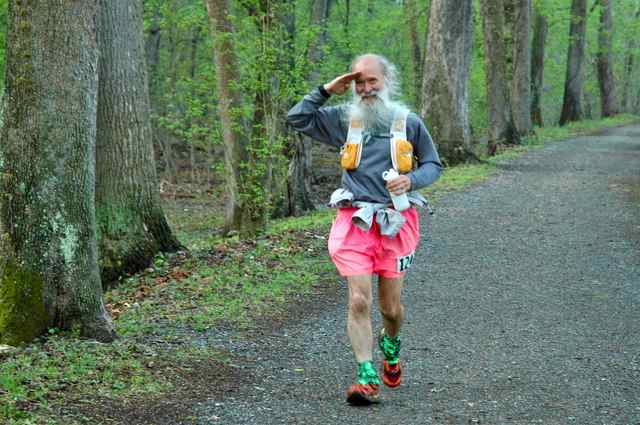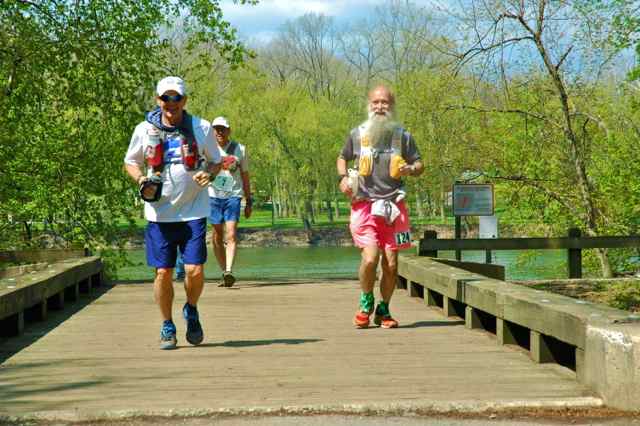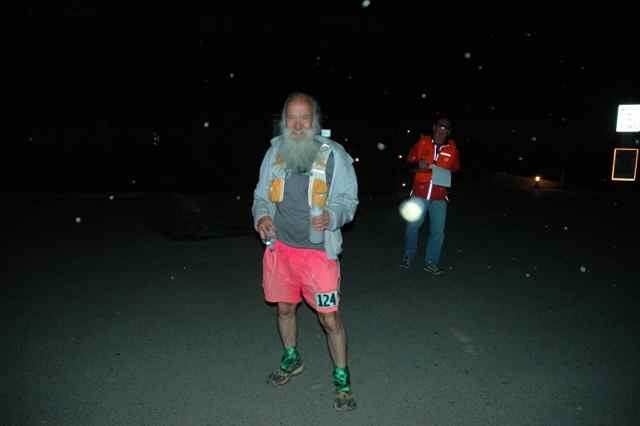~69.6 miles @ ~17.3 min/mi
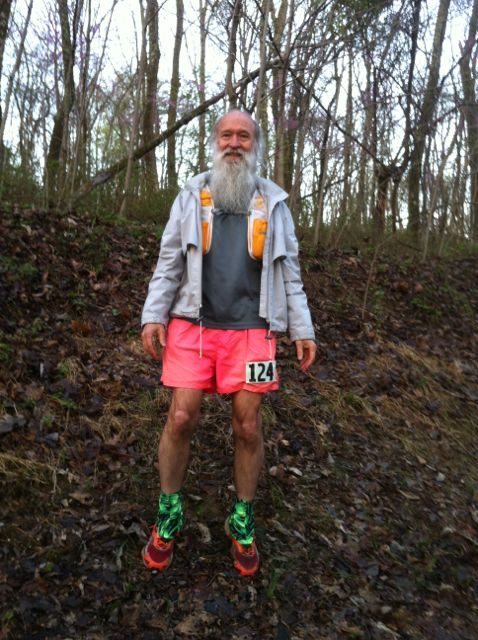
At dawn, it's almost time to start the 2014 C&O Canal 100. Many thanks to comrade Caren Jew for the spiffy electric-green-and-black gaiters!
Yet another attempt to do a 100 miler, yet another Did Not Finish = DNF. This time it's at mile 69, about 7 miles farther than the October 2013 century attempt and ~17 better than last year at this same race. At that rate of improvement perhaps there's a chance to finish one of these by 2019 or so?
The Garmin GPS trackfile records details of route and pace. Entertainingly, as with other long runs, meteorological effects during the 20 hour trek create an artificial downhill slope to the elevation chart. NOAA records show the barometer rising from 29.8" to 30.0" during the 20 hours of the race.
This photo is by Paul Encarnación (click for larger high-res image). It was taken ~7:30am at Dargan Bend, mile ~1.4 of the race.
The C&O Canal 100 course begins at Camp Manidokan, a parklike area on a ridge near Harpers Ferry on the Maryland side of the Potomac River. After a steep scramble-crawl down muddy slopes — on which I slip and fall, fortunately on my backside, no harm done — runners cross a boggy bit of the Chesapeake and Ohio Canal and join the flat gravel towpath.
Initially the race heads upstream toward the Antietam Civil War battlefield. Dargan Bend is the first aid station, seen again at about 17 miles and about 59 miles into the run.
Another great photo by Paul Encarnación (click for larger high-res image) of Butch Britton, Ed Masuoka, and ^z at mile 17, Dargan Bend.
A few miles into the C&O Canal 100 I meet Butch and Ed. We're among the three oldest participants in the race, and stick together for most of the first thirty miles. Following my companions' advice, for the next dozen hours I try to repeat the pattern "walk 4 minutes, run 1 minute". This results in a comfortable average ~15 min/mi pace. Cutoff times are ~18 min/mi so there's a margin of safety, in anticipation of deceleration at night and later in the race.
Butch and Ed discuss numismatics (Ed collects half cents, prison tokens, Early American Coppers, etc.), ultra training strategies, NASA bureaucracy, race-day nutrition, retirement plans, and a host of other topics. I explain "the remembering self" (how will this seem in retrospect?) and "the experiencing self" (how does this feel right now?) as per Kahneman's Thinking, Fast and Slow. It's so neat to make new friends during a race!
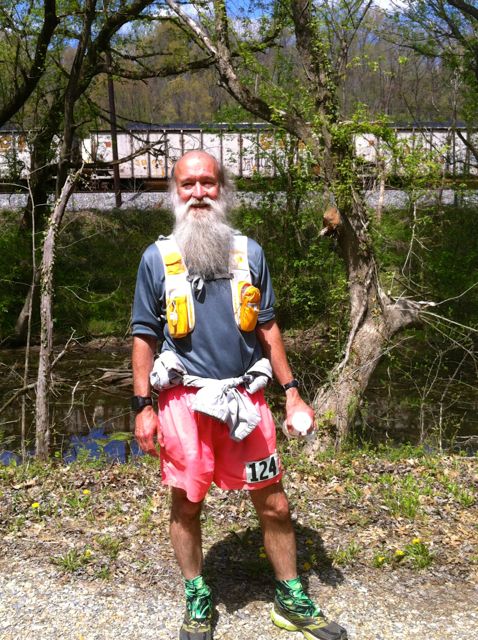
For long stretches the C&O Canal parallels the railroad line between Washington DC and Harpers Ferry WV. Butch takes this image of me about mile 30, as our pace slows and Ed treks on ahead. A few miles earlier I changed shoes at an aid station. Perhaps this was a slight mistake, as these shoes are a trifle tighter and blister formation seems to accelerate.
When a freight train starts moving, there's a loud rattle-clash sound as slack is taken up in the couplings between the cars. It propagates rapidly down the length of the train, slower than the speed of sound but still startlingly fast. We hear it several times today.
Also along the towpath are redheaded woodpeckers and other birds, bluebell flowers, and at night loudly screaming peepers (small frogs). Like last year the Audubon Society is sponsoring a One Day Hike with participants doing 50k and 100k distances, heading upstream to Harpers Ferry. A few weeks after the race, at 5:30am when I'm beginning my daily commute at the Forest Glen Metro Station, a woman greets me on the platform with, "Didn't I see you running on the C&O Canal?" Small world: it's Julia Wisniewski, a neighbor who was doing that very hike!
The last image of the day, taken about midnight at mile ~59, is also from Paul Encarnación (click for larger high-res version). "By the way," Paul notes, "all those white dots in the photo are the camera's flash reflecting off lots of flying bugs. I understand that they were providing protein to some of the runners."
After mile 38, the downstream turnaround where bad blisters make Butch drop out, I'm mostly by myself for the remaining 50 kilometers. That's not too worrisome in the daylight, but all alone at night the old brain gets lonely and the old feet aren't feeling much love.
So at mile 69, after 20 hours trekking, at 3:00am I decide to drop. Logistics here at the Brunswick aid station are optimal to stop, since comrade Mike Edwards has kind crew person Merci there who welcomes me and gives me a ride back to the start-finish. I nap, Mike finishes, and I drive him home. The next day I can walk just fine, and two days later I'm back running with friends at the office. A fine result!
Lessons learned and other observations? Major factors that contribute to relative success perhaps include:
- proper (i.e., slow) pacing of ~15 min/mi during day, ~18 min/mi at night
- lots of Baby Wipes in drop bags (thank you, Rayna, for reminding me!)
- gaiters to keep out grit and gravel (thank you, Caren!)
- helpful support by aid station volunteers and fellow runners
- lancing blisters early and letting out the fluid
- arriving at the race in good health, relatively uninjured, after some long slow runs in recent months (esp. 2014-03-22 - HAT Run 50k 2014 and 2014-04-12 - Bull Run Run 50 Miler)
Less helpful decisions may have been:
- not packing drop bags and gear until the night before the race
- not getting to bed early the night before the race (3 hours of sleep weren't enough!)
- not staying near the race start/finish, but instead riding/driving ~2 hours to get there for packet pickup on race-day morning
- not having a tent or sleeping bag, and not pausing to nap when tired
- not practicing walking more on surfaces that match the race in texture and terrain, to toughen and prepare the feet
- not eating low-fiber foods (thank goodness for clean porta-johns every 5-10 miles along the towpath!)
- not drinking saltier liquids and/or taking more powerful salt supplements (in addition to the "PR" for distance and duration, I set a "PPR", or maybe Pee-R", for great kidney activity, pausing every couple of miles) — the Enduralyte capsules provided at Aid Stations clearly did not contain enough sodium for my weird body, and the Heed drinks offered were watery compared to Gatorade
- not having a pacer or other companion during midnight-to-dawn hours — things got pretty spooky all alone 0100-0300, with every tree looking like a gargoyle in the flashlight beam, and every little stick resembling a snake on the path — and if this was scary on a near-trivial course, how would it be on a "real trail"?
- not doing more average mileage in the months leading up to the race (30-40 miles/week is perhaps minimal)
The biggest lesson of all: it's crucial to maintain a cheery attitude at all times!
Bottom line: great race, great people, great experience!
^z - 2014-06-04
